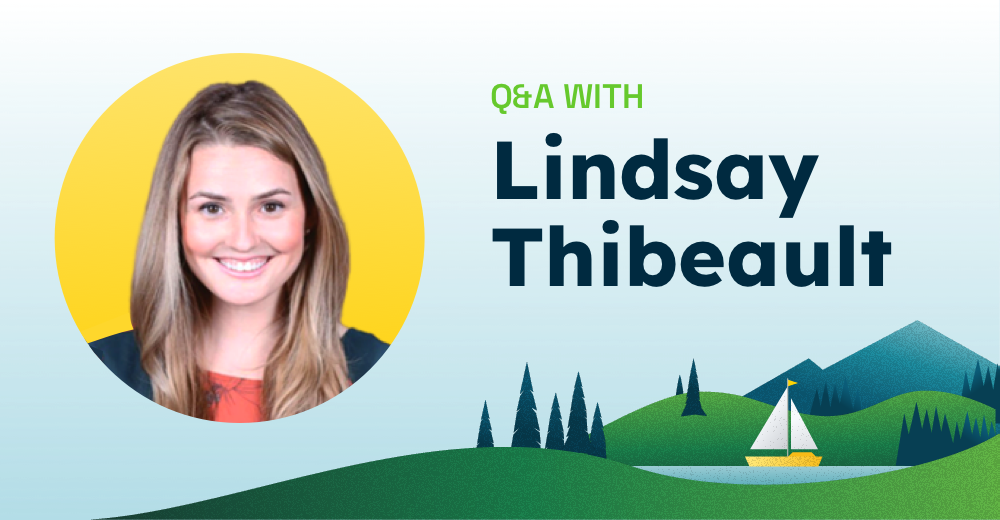
In the lead up to the Northpass-hosted webinar, "Setting the Foundation for a Successful Customer Academy," I wanted to take the time to actually get to know our three presenters — Chris LoDolce, Lindsay Thibeault and Sarah Bedrick.
In our second Q&A, I had the chance to speak with Lindsay to better understand why it's so important to take a learner-first approach. Check out the following discussion as Lindsay provides us with some lessons learned during her time at HubSpot.
Richard Posluszny: Let’s take it from the top, Lindsay! Where did your learning journey take you? What are you up to today?
Lindsay Thibeault: I began my career as a marketer and quickly fell in love with HubSpot. I noticed, however, they didn't have any content or training for me as a growing customer using the software.
Inspired by the company, and a specific education division, I joined the newly formed HubSpot Academy team in 2013. It perfectly aligned with my passion for creating customer-focused education. Shortly after joining, I took on leading our content strategy by developing a process that solved for quality, scale, and — most importantly — education.
Then, throughout 2019 and 2020, I continued my customer education journey and managed HubSpot's Customer Training team. For those that are unfamiliar, it’s a global, paid training program for HubSpot customers that need more hands-on learning. If you've ever attended an Inbound Training Day or Marketing Hub Fundamentals from HubSpot, that's the team!
Today, I'm advising businesses on how to increase their Academy's productivity and success by improving their content and operation processes.
RP: What do you think is the biggest opportunity around customer education, today?
LT: For me, customer education is about teaching people how to use and find value from your products. The biggest opportunity with customer education is making sure you develop this as a business function so it benefits customers in all stages of their journey.
And, it’s an important mindset to have early on. Customer education is what will assist and accelerate your users’ growth because it reduces those barriers and allows them to see immediate value, leading to improved skills and changed behaviors.
Customers will only see the value if you’re aware of what their journey looks like and what education is needed. Something we used on the Academy team was Clay Christensen’s Jobs to Be Done framework.
RP: At Northpass, we believe in a learner-first approach. Essentially, that means designing programs with the learner’s needs top of mind. What’s your take on this?
LT: Absolutely. Could not agree more. Learner first, always. As you’re thinking about developing an educational program, you should base your metrics around the learners’ success.
A way we did this on the HubSpot Academy team, and a good place for anyone to get started, was by building learner profiles.
We used learner profiles to inform training decisions and create content that resonated with our audiences. It also helped us make difficult decisions with confidence in areas like what kind of training to build, what content to cover and which format to use.
We found a learner profile should help answer the following questions:
-
- Who are they?
- What do they like?
- What motivates them?
- What frustrates them?
- What are their learning goals?
RP: We hear it all the time: Content is the biggest roadblock to launching a learning-powered initiative. That said, are there any other critical components that should be addressed before the content creation process?
LT: Before starting any learning-powered initiative, I clarify that while content is a form of education, it does not mean your content is educational.
For instance, even though you may have a top-performing marketing video that you know your customers enjoy, do you know if they’re able to take action or replicate what you’re trying to explain? A content approach needs to go a level deeper by creating content that teaches and leads to actionable skills.
So, a critical component to the content creation process — and why HubSpot Academy’s content gets so much feedback about its impact and quality — is making sure it incorporates an instructional design process or method.
Instructional design is the creation of learning materials that result in the acquisition and application of knowledge and skills. We adopted the ADDIE framework and adapted it to our content process.
Spending the time to incorporate this into your process will result in a bigger impact since you’re assessing the needs of your learners and developing content where you can evaluate its effectiveness.
RP: Do you have a key tip for newbies seeking to get started with a customer academy?
LT: When getting started, it’s important to have one person — or a dedicated team — that owns the customer education strategy.
It’s likely you already have some form of customer content that’s been created by your account managers, marketing team and even sales reps. Everyone will continue pitching in, but having someone own the strategy and process will make sure you’re not duplicating efforts and keep things consistent for a straightforward customer journey.
When HubSpot Academy started, several teams were creating different formats of education and content. We were always focused on making sure we were creating a consistent learning experience. We not only did that with the content that was being created and curated, but we put the time in to regularly train internal team members and employees to make sure everyone was aligned with how things were being communicated, and taught, to customers.
RP: Out of all your experiences, what would you say is the best piece of advice you received?
LT: “Done is better than perfect.”
I’m a perfectionist, which can be a real challenge when developing content. I’d often spend hours trying to perfect just a small portion of the training.
When creating education, it needs to be an iterative process. Time isn’t just spent creating the content, but also evaluating what’s working well and what’s not, and then making updates. And training, especially software training, will quickly be out of date. It’s best to put out completed work with the expectation that it can, and will be, improved.
Like What You Just Learned? Join Us.
We're getting closer to the July 8 webinar!
If you want to hear more learnings from Chris, Lindsay and Sarah, this webinar is not one to miss. Sign up via the button, below.

.png?width=3251&height=1107&name=NP_ByGS_ColorLogo%20(1).png)


